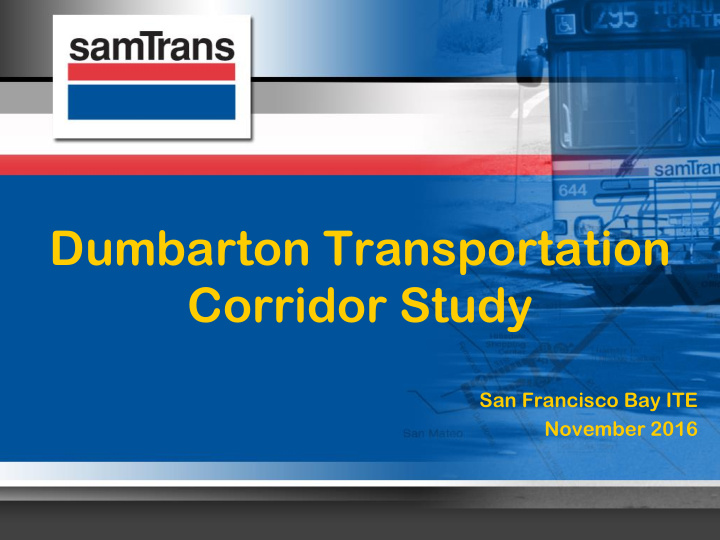



Dumbarton Transportation Corridor Study San Francisco Bay ITE November 2016
Dumbarton Corridor Source: Wikipedia 2
Dumbarton Corridor 3
Growth Imbalance • Jobs-housing imbalance • Major employers driving growth • Congestion, lengthy and unpredictable travel times • Gaps in transportation network, limited options 4
Bridge Use/Travel Markets • Almost 77,000 average daily trips • Work trips dominate transbay travel • Buses account for 5-6% of peak period use – Private shuttles account for 70% of bus ridership • Competitive travel markets: – Fremont to Palo Alto (including Stanford) – Ardenwood Park-and-Ride to Palo Alto 5
Population • Higher density in East Palo Alto, Redwood City, Union City • Peninsula study area to increase by 200,000 people (25%) by 2040 • East Bay study area to increase by 155,000 (28%) by 2040 6
Employment • Existing higher density pockets in Fremont, Palo Alto, Redwood City • Peninsula “hot spots” • Peninsula study area jobs to increase by 140,000 (28%) by 2040 • East Bay study area jobs to increase by 62,000 (24%) by 2040 7
Background • Dumbarton Rail Corridor Alternatives Study completed in 2011 • Environmental review process on hold due to high costs and lack of funding • Bay Area has since experienced job growth, increased congestion and greater jobs-housing imbalance 8
Transportation Study • Initiated due to recent growth • Study partners: − SMCTA − ACTC − AC Transit − Facebook • Kicked off in March − 15-month schedule 9
Scope of Work • Study mobility improvements on highway bridge, approach arterials and rail bridge • Focus on short-term (2020) and long- term (2030) improvements and phasing 10
Study Process 11
Outreach • Outreach at major milestones: − May 2016: Existing conditions, goals and evaluation metrics, initial alternatives − September 2016: Initial screening, alternatives carried forward − May 2017: Evaluation of alternatives carried forward, funding plan 12
Goals, Evaluation Metrics • Enhance mobility − Capacity (benefitting transit for highway alternatives) − Ability to serve regional travel markets (transit alternatives only) − Service frequency (transit alternatives only) • Cost effective improvements with return on investment − Capital and operating costs 13
Goals, Evaluation Metrics • Minimize environmental impacts, financial risk and maximize safety − Environmental impacts − Financial risk − Safety • Ensure local communities are protected from adverse impacts − Disproportionate burden on low-income populations − Disparate impacts on minority populations 14
Initial Highway Bridge Alternatives • Dumbarton Express enhancements • Managed lanes (carpool, toll or bus-only) configurations that fall into three categories: − Utilize existing cross section − Convert existing bike/ped to vehicle lane with bike/ped replaced on rail bridge − Convert existing bike/ped to vehicle lane with bike/ped replaced on cantilevered deck 15
Initial Approach Alternatives • Improvements to: − Make tolling more efficient − Improve carpool connections − Manage and/or increase park-and-ride capacity − Provide additional capacity/improve flow on key arterials and at intersections − Improve connections to US 101 16
Initial Rail Bridge Alternatives • Transit modes: − Bus Rapid Transit (BRT) − Commuter Rail − Bike/ped − Light Rail Transit (LRT) − Bay Area Rapid Transit (BART) − Personal and Group Rapid Transit − People Mover − Hyperloop − Tunnel (BRT, LRT, Commuter Rail) − Ferry − Gondola 17
Initial Screening Process • Step 1: − Scored highway configurations for highway bridge − Identified approach improvement packages that prioritize transit in long-term − Scored transit modes for rail bridge • Step 2: − Scored best performing transit modes with consideration for operating plans • Carried forward all short-term options 18
Highway Bridge Alternatives Carried Forward • Short-term: enhanced Dumbarton Express service • Long-term: 3 managed lane options 19
Highway Bridge Alternatives Carried Forward • Contraflow managed lane in median with movable barrier 20
Highway Bridge Alternatives Carried Forward • Reversible managed lanes in median with fixed barriers 21
Highway Bridge Alternatives Carried Forward • Managed lane in each direction • Reversible managed lanes in median with fixed barriers 22
Approach Packages • Short-term: − Bike/ped approach improvements − Manage/expand park-and-ride − Carpool/toll direct access ramp at Newark − Extension of FasTrak lane eastward − Open road tolling at FasTrak lanes − Transit signal priority or queue jump lanes on Decoto and at Bayfront/Willow, Bayfront/University − Bus lanes on Bayfront 23
Approach Packages • Long-term: − All electronic tolling for cash lanes − Add eastbound carpool/toll from toll plaza to Decoto − Managed lanes on US 101 − Carpool/toll direct access ramp at US 101/Marsh − Grade separations at Bayfront/Willow and Bayfront/University − Willow Express lanes − I 880/SR 84 direct connector ramps 24
Rail Bridge Alternatives Carried Forward • Short-term: − Bike/ped on peninsula • Long-term: − BRT from Union City BART to Redwood City Caltrain − Commuter Rail from Union City BART to Redwood City 25
Next Steps • September – December: Further study alternatives carried forward − Conceptual engineering − Ridership modeling − Financial analysis including public-private partnerships • January: Comparative alternatives analysis • February: Recommend phasing and financial plan 26
Comments / Questions 27
Opportunities to Comment • Stakeholder/public meetings • Website: www.samtrans.com/DBCstudy • Email: reggiardom@samtrans.com • Telephone: 650-508-6283 • Mail: Attention Melissa Reggiardo, San Mateo County Transit District, P.O. Box 3006, 1250 San Carlos Avenue, San Carlos, 94070 28
Recommend
More recommend